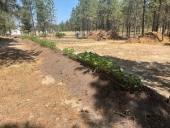Alas, most of the tropicals you might wish to grow want not only light, but also heat and humidity to do well. Some other issues you might see with tropicals, grown indoors here in the temperate zone, are: minor nutrient deficiencies, and insect pests, typically scale (on citrus) and whiteflies (on pineapples). Additionally, you need to be mindful of the pollination requirements, if you want fruit. Avocados, for example, require two cultivars that must have complementary flowering patterns (it's quite complex); most other fruit requires only two two separate cultivars blooming at the same time. You must hand-pollinate, though, if they're flowering in winter (as citrus may).
I'd go with citrus (grafted only, seedlings are tall and very thorny!), and perhaps cultivars of Barbados cherry (Malpighia glabra), which has small but delicious fruit. Also, carambola (star-fruit) takes well to containerization.
Avocados must also be grafted; seedlings will easily top your space without deigning to bloom.
Don't grow pineapples from the tops (crowns); the result will be miniaturized fruit. Use only root-suckers, as is done commercially. Your nursery source should know the difference (it's an epigenetic effect, and fruit sizes may be arbitrarily scaled up and down by propagation from tissue from bottom or top of the plants).
If you have further questions on specific species, query me at:
stanton.deriel@yahoo.com
-- Stan











